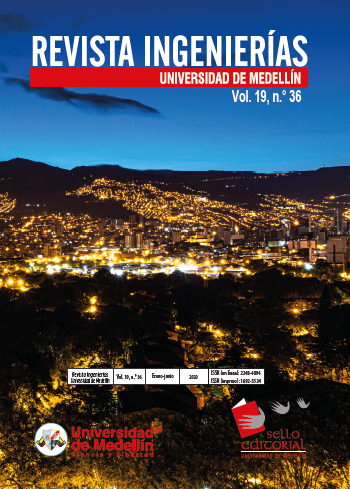Análisis de QoS para IPTV en un Entorno de Redes Definidas por Software
Contenido principal del artículo
Resumen
El despliegue masivo de servicios, soportados en la tecnología del videostreaming, trae consigo la expansión de redes de datos y el crecimiento del ancho de banda necesario para transportar la información. Esto, a su vez, demanda mayores capacidades de control y gestión de red que permitan garantizar calidad de servicio (QoS) al usuario final. Tal demanda ha impulsado la innovación de las arquitecturas de red. Surgen así las redes definidas por software (SDN), paradigma de arquitectura de red donde se desacoplan los planos de datos y control. Así, este artículo analiza, para uno de los servicios de videostreaming, como lo es la televisión sobre el protocolo IP (IPTV), las métricas de QoS sobre una red SDN real y emulada. Los resultados demuestran que es posible igualar la QoS de una arquitectura convencional, ofreciendo otras ventajas a la red como la lógica centralizada y programabilidad desde el plano de gestión.
Detalles del artículo
Citas
[1] J. Bailey y S. Stuart, 'Faucet: Deploying SDN in the enterprise', Commun. ACM, [En línea], vol. 60, n.° 1, pp. 45-49, Dec. 2016. DOI: https://dl.acm.org/citation.cfm?doid=3028256.3009828
[2] D. Kreutz, F. M. V. Ramos, P. Esteves Verissimo, C. Esteve Rothenberg, S. Azodolmolky, y S. Uhlig, 'Software-Defined Networking: A Comprehensive Survey', Proc. IEEE, [En línea], vol. 103, n.° 1, pp. 14-76, Jan. 2015. DOI: 10.1109/JPROC.2014.2371999
[3] Cisco, 'Cisco Visual Networking Index: Forecast and Methodology, 2015-2020', Forecast Methodol., p. 22, 2015.
[4] Ericsson, 'Ericsson Mobility Report November 2018', 2018. Estocolmo: Ericsson. Disponible: https://www.ericsson.com/en/mobility-report
[5] R. Jain y S. Paul, 'Network virtualization and software defined networking for cloud com-puting: A survey', IEEE Communications Magazine, [En línea], vol. 51, n.° 11. pp. 24-31, Nov-2013. DOI: 10.1109/MCOM.2013.6658648
[6] A. Tong y K. Wade, NFV and SDN Guide for Carriers and Service Providers, 1st ed. Blueplanet, 2017, 36 p.
[7] D. L. C. Dutra, M. Bagaa, T. Taleb, and K. Samdanis, 'Ensuring End-to-End QoS Based on Multi-Paths Routing Using SDN Technology', in GLOBECOM 2017 - 2017 IEEE Global Communications Conference, [En línea], pp. 1-6, 2017, DOI: 10.1109/GLOCOM.2017.8254076
[8] J. W. Kleinrouweler, S. Cabrero, and P. Cesar, 'Delivering stable high-quality video: an SDN architecture with DASH assisting network elements', in Proceedings of the 7th International Conference on Multimedia Systems - MMSys ’16, [En línea], pp. 1-10, 2016, DOI: https://dl.acm.org/citation.cfm?doid=2910017.2910599
[9] S. Ramakrishnan, X. Zhu, F. Chan, and K. Kambhatla, 'SDN Based QoE Optimization for HTTP-Based Adaptive Video Streaming', in 2015 IEEE International Symposium on Multimedia (ISM), [En línea], pp. 120-123, 2016, DOI: 10.1109/ISM.2015.53
[10] J. Wang, C. de Laat, and Z. Zhao, 'QoS-aware virtual SDN network planning', in 2017 IFIP/IEEE Symposium on Integrated Network and Service Management (IM), [En línea], pp. 644-647, 2017, DOI: 10.23919/INM.2017.7987350
[11] P. L. Agudelo, W. Y. Campo, A. Ruíz, J. L. Arciniegas, and W. J. Giraldo, 'Architec-tonic Proposal for the Video Streaming Service Deployment Within the Educational Context', Springer, Cham, [En línea], pp. 313-326, 2017, DOI: https://link.springer.com/chapter/10.1007/978-3-319-66562-7_23
[12] D. Maldonado, Diseño e implementación de una aplicación de red bajo la arquitectura SDN, Bogotá:Universidad Javeriana, 2014.
[13] J. Alcorn, S. Melton, and C. E. Chow, 'SDN On-The-Go (OTG) physical testbed', in 2017 IEEE Conference on Dependable and Secure Computing, 2017, [En línea], pp. 202-208. DOI: 10.1109/DESEC.2017.8073808
[14] M. Aziz, H. A. Fazely, G. Landi, D. Gallico, K. Christodoulopoulos, and P. Wieder, 'SDN-enabled application-aware networking for data center networks', in 2016 IEEE International Conference on Electronics, Circuits and Systems (ICECS), 2016, [En línea], pp. 372-375. DOI: 10.1109/ICECS.2016.7841210
[15] L. Wang, H. Ruan, H. Li, and Q. Liu, 'Combining Neutron and OpenDaylight for Management of Networking', in 2017 IEEE 41st Annual Computer Software and Applications Conference (Compsac), 2017, [En línea], pp. 457-462. DOI: 10.1109/COMPSAC.2017.89
[16] M. Erel, E. Teoman, Y. Ozcevik, G. Secinti, and B. Canberk, 'Scalability analysis and flow admission control in mininet-based SDN environment', in 2015 IEEE Conference on Network Function Virtualization and Software Defined Network (NFV-SDN), 2015, [En línea], pp. 18-19. DOI: 10.1109/NFV-SDN.2015.7387396
[17] Y. Xiao, X. Du, J. Zhang, F. Hu, and S. Guizani, 'Internet Protocol Television (IPTV): The Killer Application for the Next-Generation Internet', IEEE Commun. Mag., [En línea], vol. 45, n.° 11, pp. 126-134, Nov. 2007, DOI:10.1109/MCOM.2007.4378332
[18] R. Mohammadi, R. Javidan, and M. Keshtgari, 'OpenIPTV: a comprehensive SDN-based IPTV service framework', Multimed. Syst., [En línea], vol. 24, n.° 3, pp. 313-325, Jun. 2018, DOI: https://doi.org/10.1007/s00530-017-0553-x
[19] UIT, 'Network performance objectives for IP-based services', [En línea], Disponible: https://www.itu.int/rec/T-REC-Y.1541/en, 2011.
[20] UIT, 'IPTV Focus Group Proceeding', [En línea], Disponible: http://www.itu.int/pub/T-PROC-IPTVFG-2008/en, 2008.
[21] Fundación Blender, 'Big Buck Bunny', [En línea], acceso 23 de septiembre, 2017; Disponible: http://www.bigbuckbunny.org
[22] X. Liu, M. Tanaka, and M. Okutomi, 'Noise Level Estimation Using Weak Textured Patches of a Single Noisy Image', in 2012 19th IEEE International Conference on Image Processing, [En línea], pp. 665-668, 2012, DOI: 10.1109/ICIP.2012.6466947





